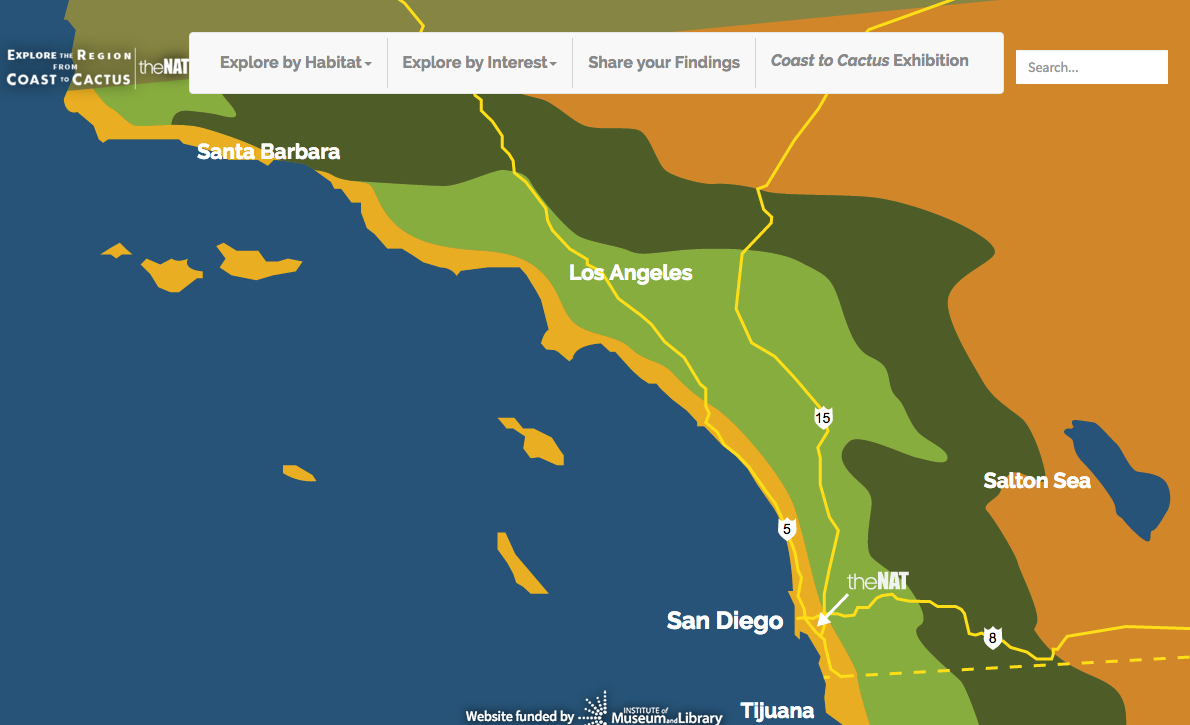- Client:
San Diego Natural History Museum - Services:
Design and Development - Funder:
Institute of Museum and Library Services
Explore the Region from Coast to Cactus is an interactive website, built using the flat file content management system Statamic, that illustrates the biological richness of Southern California by taking users on a journey through its diverse habitats and the plants and animals that live in them. Featuring species profiles, habitat descriptions, unique places to visit, and stories about the people who have deepened our understanding of the region, The San Diego Natural History Museum (TheNAT)'s Explore the Region from Coast to Cactus is a dynamic tool that gives users the ability to go out, identify and record species, and explore the region on their own.

In January 2015, TheNAT opened a new, 8,000 square foot permanent exhibition, Coast to Cactus in Southern California, that invites visitors to explore the unique habitats of Southern California. San Diego is known for its incredibly diverse terrain, ranging from the beaches and chaparral near the coast, to the mountains and the desert farther afield. This terrain is what makes the region one of only 35 biodiversity hotspots in the world, meaning areas that have the highest concentration of different species of any geographic area of similar size. BPOC, in collaboration with TheNAT staff, developed a website to accompany the exhibition. The goal was to produce a web-based interactive map of the exhibition that enhanced visitors’ understanding of the southern California region, fostered caring and stewardship of natural places, and deepened citizens’ sense of place in the region.
Throughout the site design process, TheNAT engaged a user testing firm to conduct an evaluation of the website in order to assess its clarity, usability, and intuitiveness. The evaluation was conducted on an in-progress beta site utilizing a Heuristic Evaluation and Think Aloud User Tests. The initial evaluation showed room for improvement. After reviewing the findings of the evaluation, BPOC redesigned the website from top to bottom, addressing the identified issues.

The current iteration of the website is centered on a colorfully designed map. The site is fully responsive and optimized for a wide range of devices and browsers. Users can click on the different areas of the map or use the nav bar to bring up windows full of images that showcase the region’s diverse flora and fauna. Clicking on the image of an animal or plant brings users to a rich description, that often includes supplemental video and audio content.
This version of the site was user-tested as well. The user testing brought a great deal of positive feedback. In a think-aloud exercise, one user noted, “The site is just really easy to navigate. I got what I needed. Just playing with the website, I have an idea of where I can find stuff.” Another tester, a teacher, noted, “California standards for 2nd, 3rd and 4th grades are all studying this (content) … I could see myself using this as a resource in my classroom.” Incorporating constructive feedback, BPOC and TheNAT designed and built a site that is both user-friendly and useful.
